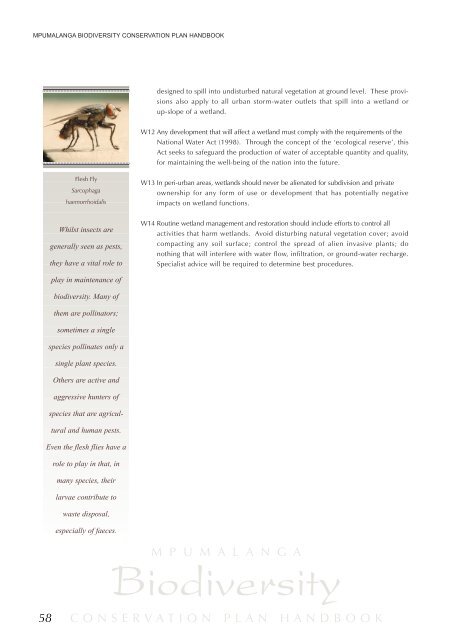Mpumalanga Biodiversity Conservation Plan Handbook - bgis-sanbi
Mpumalanga Biodiversity Conservation Plan Handbook - bgis-sanbi
Mpumalanga Biodiversity Conservation Plan Handbook - bgis-sanbi
Create successful ePaper yourself
Turn your PDF publications into a flip-book with our unique Google optimized e-Paper software.
MPUMALANGA BIODIVERSITY CONSERVATION PLAN HANDBOOK<br />
58<br />
Flesh Fly<br />
Sarcophaga<br />
haemorrhoidalis<br />
Whilst insects are<br />
generally seen as pests,<br />
they have a vital role to<br />
play in maintenance of<br />
biodiversity. Many of<br />
them are pollinators;<br />
sometimes a single<br />
species pollinates only a<br />
single plant species.<br />
Others are active and<br />
aggressive hunters of<br />
species that are agricul-<br />
tural and human pests.<br />
Even the flesh flies have a<br />
role to play in that, in<br />
many species, their<br />
larvae contribute to<br />
waste disposal,<br />
especially of faeces.<br />
designed to spill into undisturbed natural vegetation at ground level. These provisions<br />
also apply to all urban storm-water outlets that spill into a wetland or<br />
up-slope of a wetland.<br />
W12 Any development that will affect a wetland must comply with the requirements of the<br />
National Water Act (1998). Through the concept of the ‘ecological reserve’, this<br />
Act seeks to safeguard the production of water of acceptable quantity and quality,<br />
for maintaining the well-being of the nation into the future.<br />
W13 In peri-urban areas, wetlands should never be alienated for subdivision and private<br />
ownership for any form of use or development that has potentially negative<br />
impacts on wetland functions.<br />
W14 Routine wetland management and restoration should include efforts to control all<br />
activities that harm wetlands. Avoid disturbing natural vegetation cover; avoid<br />
compacting any soil surface; control the spread of alien invasive plants; do<br />
nothing that will interfere with water flow, infiltration, or ground-water recharge.<br />
Specialist advice will be required to determine best procedures.<br />
M P U M A L A N G A<br />
<strong>Biodiversity</strong><br />
CONSERVATION PLAN HANDBOOK

















